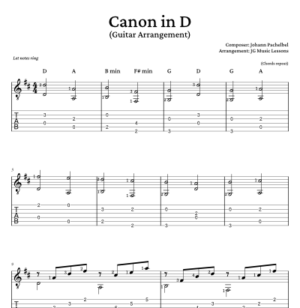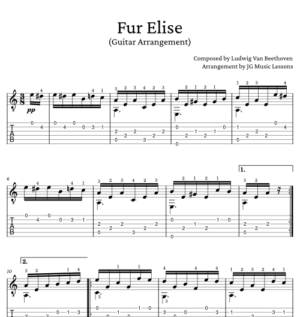Understanding time signatures are essential to reading music but can be confusing to learn for beginners. This easy to follow guide will teach you what time signatures are and how to read them so you can start playing your favorite songs.
Let’s get started!
What is a time signature?
A time signature is a music symbol that indicates how to read the timing of notes in a piece of music. This symbol indicates the length of each measure, which is a fragment of time that repeats throughout a song.
The following chart shows you some of the basic elements used to notate music.
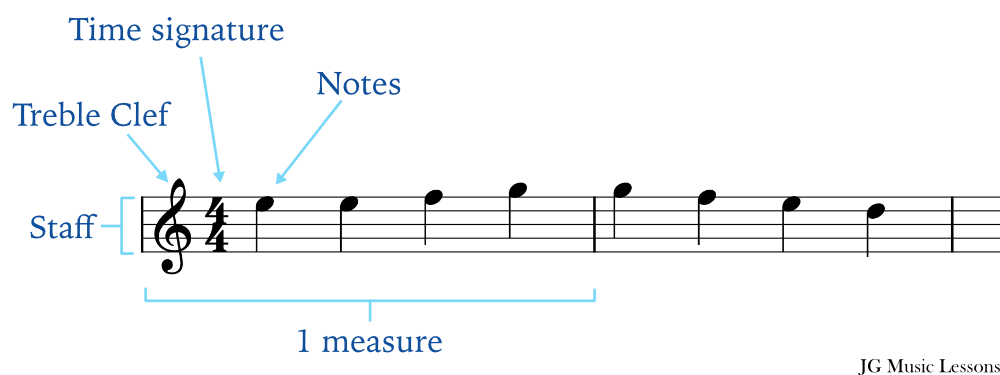
Here is a brief explanation of some of these notation elements:
- The notes are the pitches that make up a melody or phrase.
- The staff is the five lines used to write notes, either in between lines or on a line.
- A treble clef indicates the names of the notes written on the staff lines. (There are other clefts like bass clef or alto clef.)
- A measure is a fragment of time that repeats throughout a song.
This other lesson covers how to read the essential music symbols.
Common time signatures
The three most common time signatures in music are 4/4, 3/4, and 6/8.
In short, 4/4 time signature means each there are four beats per measure. The symbol looks like this:

The 3/4 time signature means each there are three beats per measure. The symbol looks like this:

The 6/8 time signature means each there are six beats per measure. The symbol looks like this:

To better understand how these time signatures work, let’s dive further into what these numbers mean.
What do the numbers on top and bottom mean?
The top number tells you how many notes are in a measure.
The bottom number tells you the note value (what type of note fills each beat).
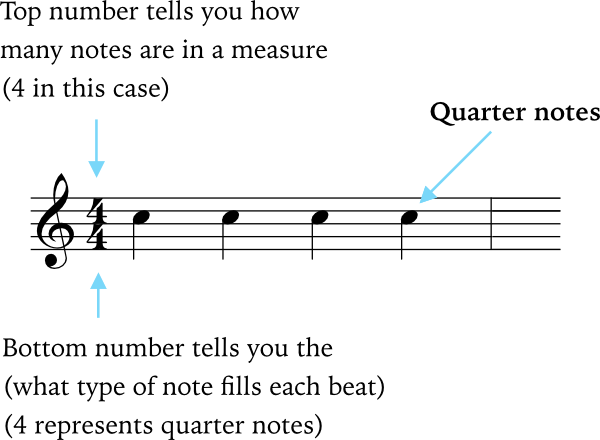
4/4 time signature
The 4/4 time signature means that four quarter notes can make up one measure. Later on, we will see what other note values can fit in a 4/4 measure.
3/4 time signature
The 3/4 time signature means that three quarter notes can make up one measure.

6/8 time signature
And for the 6/8 time signature, the bottom number 8 represents eighth notes which look like this:

When there are consecutive eighth notes, they are joined by horizontal
lines that look like this:
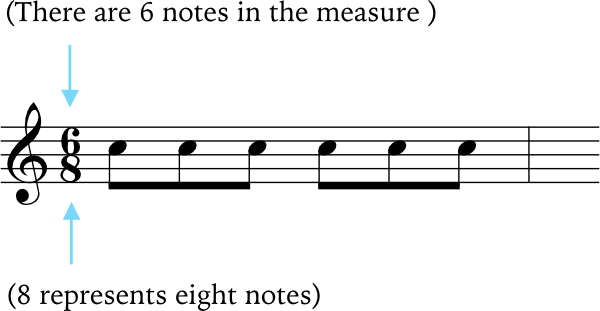
Common note symbols and how long they last
Here are some common note symbols and how long they last in a 4/4 time signature:
- Whole notes last four beats.
- Quarter notes last one beat.
- Half notes last two beats.
- 8th notes last for half a beat.
Here is a chart to show you the symbols along with their rest equivalents, meaning silence in music.
Note symbols and rest equivalents (silence)
Whole notes
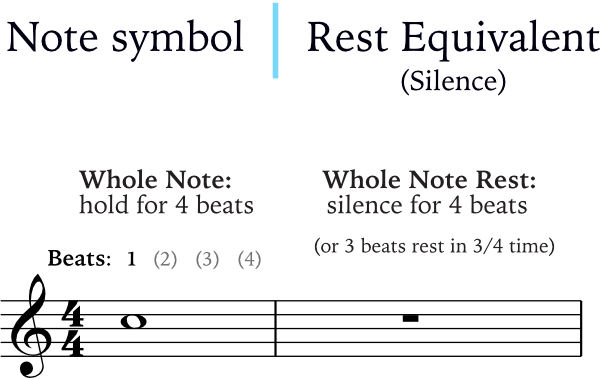
Half notes

Quarter notes

Eighth notes

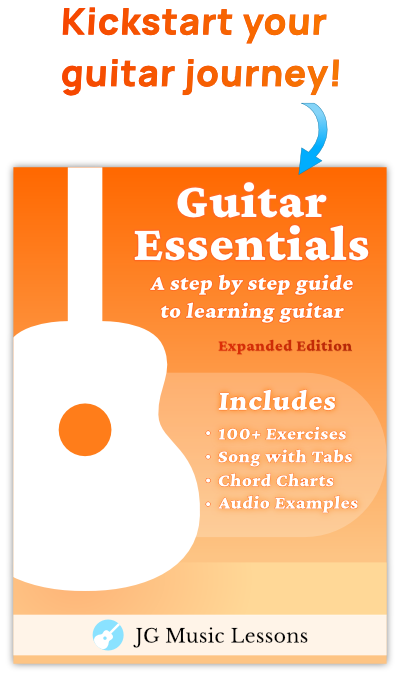
Dotted note symbols
Whenever you add a dot to any note, you are increasing the length by half of its value (50%).
Dotted half note
For example, in a 3/4 time signature, a dotted half note becomes three beats.

Dotted quarter note
In a 4/4 time signature, a dotted quarter note becomes one and a half beats.

How note values change according to the time signature
Note that each note length can change depending on what time signature they are used in. For example, a quarter note in 4/4 time lasts one beat but lasts two beats in 6/8 because the bottom number of the time signature is different.
In the image below, the numbers in parenthesis mean that the note is still being held on that beat. The point I’m making here is that we can’t always think of quarter notes as one beat because in 6/8 time, they would technically last for two beats.

Note values in 4/4 time signature example

Note values in 3/4 time signature example

Note values in 6/8 time signature example

What is common time?
Common time is the same thing as a 4/4 time signature (which can fit four quarter notes in a measure).
It is indicated by a C symbol on the staff like this:

What is cut time?
Cut time is a 2/2 time signature which means two half notes fill up a measure. Even though the time lasts the same as a 4/4 time signature, the emphasis of the beats is different. In cut time, beats 1 and 2 are the strong beats whereas in 4/4 the emphasis is typically on beats 1 and 3.
This can be used to simplify counting and make the rhythms more approachable to read without having to write as many 8th notes or 16th notes (1/16 of a quarter note).
The symbol for cut time looks like a C with a line through the middle like this:

Wrapping up
We covered the basic elements to understanding time signatures, which indicate how long each measure lasts and how note values can fit in each measure.
We mentioned how the three most commonly used time signatures are 4/4, 3/4, and 6/8 time. The top number tells us how many beats are in the measure and the bottom number tells us what note value they are.
We went over the different note values and how they can fit depending on the time signature. We also covered what common and cut time are and the symbols used for these time signatures.
Feel free to checkout the sheet music with tabs resource to practice reading music with different time signatures.
📘 Get the free guitar practice guide here!
All the best,
JG Music Lessons
Start Playing Better, Faster
with Pro Membership! ✨
Get the guidance, tools, and support that keep your progress on track:
🏁 Always know what to practice next. Access the full Guitar Learning Roadmap with lessons in sequence.
🎼 Play songs with confidence. Step-by-step lessons of popular, classical pieces and other styles.
📙 Save time and frustration. Clear PDFs and ebooks that save time so you can focus on playing.
🎟️ Get rewarded for consistency. 2 free downloads every month (a $240+ yearly value).
🎁 Keep costs low while you grow. 50% off all charts, tracks, and posters — up to 75% off bundles.
🚫 Stay focused. Ad-free environment keeps you in the zone.
💬 Get help when you need it. Direct member support to keep you on track.



